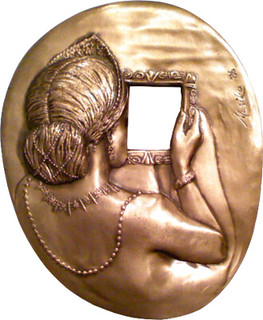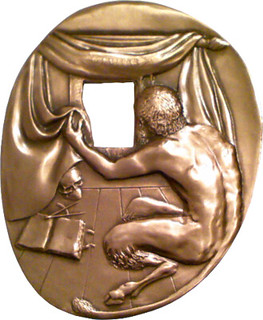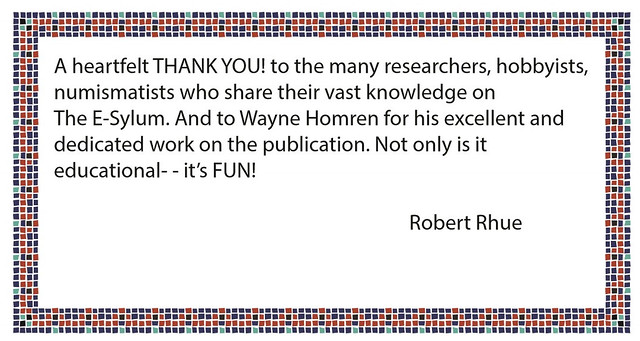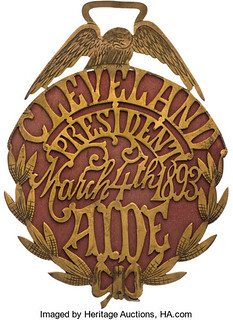
PREV ARTICLE
NEXT ARTICLE
FULL ISSUE
PREV FULL ISSUE
VOCABULARY TERM: OPENWORKDick Johnson submitted this entry from his Encyclopedia of Coin and Medal Terminology. Thanks. -Editor Openwork. A pierced coin or medal, with an opening made as part of its artistic design, or cut out at a later time. Coins are found with square or round holes in the center, with little other openwork design. Openwork medals are somewhat more artistic in that the open area is usually not in the center but appears elsewhere in the design, as part of the artistic expression. All openwork is cut entirely through the item forming the most severe treatment and allowing showthrough with a view of any thing placed behind it. Sometimes the background or some portion of the field is pierced out to give emphasis to the device. Many of the higher ranked decorations are pierced to give them this element of device emphasis and because this is so rarely done – because of the high cost – it gives these decorations an exclusiveness in the medallic field. As a design element openwork must be worked into both obverse and reverse design. Like statues and other sculpture in-the-round, openwork is also considered as NEGATIVE SPACE, that is, the space is not filled with matrix (the metal) or design. Because of this removal, openwork is similar to silhouetting in three ways: the matrix is removed, the outlining gives it a "hard edge," to the design and permits showthrough of anything behind the item. Silhouetting is the cutting around the edge, while openwork is the cutting out entirely within the object. See silhouette. Openwork created by the designer of the item is considered legitimate and what was intended. Openwork that is done after the numismatic item has been issued is considered by some people as the most egregious form of graffiti. Examples include both cutout coins and medals to create a form of numismatic jewelry. The cutout Columbian Commemorative Half Dollar of 1892-93 illustrated here is perhaps the most notable (or notorious) example depending upon a person's viewpoint. How openwork is obtained. Openwork on cast objects present no difficulty in their formation. It is just as easy to form an object with openwork by casting as it is a solid object. However, for struck objects, openwork requires great attention and tooling. Such openwork is produced by any of several ways: (1) pre-forming the blank by piercing the strip stock before the blank is cutout; (2) by piercing as one step in the use of a progressive die (see combination die), (3) by piercing with a piercing die on a separate run through a punch press after the piece is struck; or 4) by handworking with a jewelers saw. Tooling for piercing is made of the hardest tool steel – drill rod – to effect the pierced opening. In effect, the steel punch pushes the soft metal through the piercing die, a tool with a hard edge surrounding the aperture made to the exact configuration of the required opening. The punch plate holds the punch die and it too has an opening in it (somewhat larger than the aperture in the die). The punch pushes the metal being removed through openings in both of these and it falls below as scrap. See piercing. Openwork coins and tokens. The early cash coins of China with their square hole in the middle – among the first such numismatic objects with openwork – were created with the square hole for the utilitarian purpose of carrying many coins on a square stick. The casting of the coins provided little difficulty as casting can easily create openwork. In modern times coins with openwork are struck with combination dies, which with one blow can pierce, blank and emboss the design all in one blow. It is done in stages, at the first position the blank strip is pierced, at the second position the relief design is struck and the third position the piece is blanked out of the strip. The strip moves in a prescribed distance to keep each function in close register. Tokens, as transportation tokens, with many kinds of openwork centers, are typically struck with combination dies in this manner. An official of Osborne Coining, Charles Stegman, received U.S. patent number 3,338,084 in 1967 for the progressive die to strike, blank and perforate such tokens in one cycle of the press. Openwork medals. The design dictates where a medal will be pierced and the quantity dictates how it will be pierced. If only a small quantity is required it is cost effective to hand jigsaw the needed pieces. If a large quantity is required (say, over fifty) a piercing tool is created by a tool and diemaker. It includes a punch, a die, a punch holder and a plate; sometimes a nest is also required for a critically designed piece to rest in the exact position to be pierced.
A Belgian medal, shows a pierced area – the small window in a prison door – on one side a woman brings food to a prisoner, on the other the prisoner reaching for the food. A more modern piece is an issue of the Society of Medalists showing both beauty and the devil looking into a mirror, the openwork area. See illustrations. 

While a hole in a medal for suspension is technically openwork, it is not always so. If the artist intends it to be drilled the designer often includes a limiting guide, as a circle identifying the locus where the hole is to be made. When cataloged such an intended hole is noted as a drill hole. A hole drilled into any numismatic item not intended by the designer is considered vandalized. Decoration with openwork. Designers of high ranking decorations have employed openwork to the greatest degree. Since elaborate tooling is required for the piercing this process is expensive but it adds the greatest amount of exclusiveness to the piece. The United States Congressional Medal of Honor has openwork around a central star and within a wreath. This requires not one but two piercing runs because of the closeness of pierced areas to each other. Cutout coins and medals. Anyone with a jewelers saw, a drill, a vise and a great deal of patience can cut an open area in a coin or medal. Generally a large piece is chosen with a portrait, device or design element that can be recognized after it is cutout. The design remaining must be attached to some portion of the rim (if the central device was entirely cut around it, obviously, it would fall out). In so doing, the entire design on the opposite side is destroyed. The legend for such a cutout coin is a major problem, in that some cutout items omit this, but if it is cutout a portion of it is left connected to the rim. Columbus portrait on the obverse and his ship on the reverse of the Columbian Commemorative half dollar are excellent examples of cutout coins. See cutout. Openwork in a coin or medal design that is not pierced – but intended to mean hollowed out – is called voided, the term from heraldry. A French coin, created for circulation in Canada and Louisiana Territory and listed in Breen (278) has a cross on the reverse and is described as a voided cross. It bears an outline of a square-arm cross that is empty of design in the interior, precisely the meaning of voided. Openwork as the design. In 1930 a Pittsburgh inventor (Ollie S. Letzkus) received a design patent for an openwork item he called a Shadowgraphic Token. It was made of sheet brass with perforated openings, which, when held to a light cast a shadow of a design. His patented design (D83,734) formed the shadow of Christ's head. While an ingenious design, little more was done with his creation. Openwork also includes filigree – lace-like openwork design – sometimes found on the border to bezels or plaques. The French word for openwork in coins and medals is ajoure. The use of the word "perforated" is discouraged in the numismatic field as it does not have the more exact meaning of similar terms listed here.
Reference: Looking for the meaning of a numismatic word, or the description of a term? Try the Newman Numismatic Portal's Numismatic Dictionary at: https://nnp.wustl.edu/library/dictionary Or if you would like a printed copy of the complete Encyclopedia, it is available. There are 1,854 terms, on 678 pages, in The Encyclopedia of Coin and Medal Technology. Even running two a week would require more than 19 years to publish them all. If you would like an advance draft of this vital reference work it may be obtained from the author for your check of $50 sent postpaid. Dick Johnson, 139 Thompson Drive, Torrington, CT 06790. 
Wayne Homren, Editor The Numismatic Bibliomania Society is a non-profit organization promoting numismatic literature. See our web site at coinbooks.org. To submit items for publication in The E-Sylum, write to the Editor at this address: whomren@gmail.com To subscribe go to: https://my.binhost.com/lists/listinfo/esylum All Rights Reserved. NBS Home Page Contact the NBS webmaster 
|
